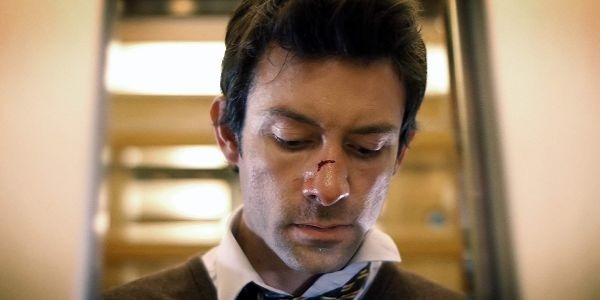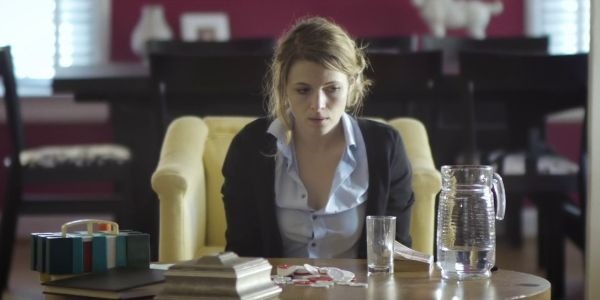Biological Uncertainty In UPSTREAM COLOR

Alex is a film addict, TV aficionado, and book lover.…
There’s a moment of sheer panic in Shane Carruth’s Upstream Color that I’ve rarely seen matched. People run and punch and flail against a threat they cannot see or understand, lashing out in a completely instinctual way that feels at once insane and logical. The two people being overwhelmed by this sensation end up taking refuge in their tub, resigned to simply wait out whatever is going on.
It’s a moment I responded to long before our current state of affairs, but considering how many of us are stuck at home with a vague but powerful sense of anxiety about the COVID-19 pandemic, I’m guessing a lot more people will understand what I see in this visceral freak-out. It’s our utter lack of control, our illusion of order, and how quickly these things can slap us in the face.
Most of us knew in the back of our minds that a virus could bring the world to a halt. Scientists have been saying it for decades, and long before that humans simply lived with rampant diseases. Art has dealt with pandemics and their crippling effects since square one, but the strange divide between art and science has often left some stark realities, ones we’re all being forced to grapple with now, largely absent.
Despite spending a lot of time and energy watching, studying, and analyzing movies, I’m actually a scientist by training, having studied biology, psychology, and animal behavior at university. I know the bits about a scientifically trained mind that gets left out of pop culture, particularly the sensation of knowing how much we don’t know. Because that’s what science actually is, poking at what we don’t know, and a side effect of that is knowing how little of our lives are under our conscious control. If you let yourself think about that, it can bring on a strange, existential panic, one that Upstream Color captures in a beautifully unnerving way, and one that has suddenly become a widespread feeling.
Keeping It Real
At its core, Upstream Color is about not understanding yourself, but instead of exploring this through a grand melodrama or some pop psychology lens, its approach is straight through the hard sciences. No, that does not mean it’s stuffy or boring, and it does not mean I can explain the fictional life cycle that drives this existential wormhole. But it is a parasite that throws the main characters for a loop, which is a fascinatingly singular point of entry.

Did you catch that? This movie makes up an entire life cycle, one that’s vaguely hinted at through color and deeply tickles my biology brain. It appears to move from plant to worm to human to pig and back to the plant, causing strange behavior in human hosts and some sort of psychic connection between pig and human. I know, I know, a psychic connection isn’t exactly scientific, but the point here isn’t to make a rigorous outline of a feasible life cycle. The point is to capture what it’s like to be caught up in one you don’t understand, to have it change your life and your personality in such fundamental ways that it shakes your idea of the world to its core.
This happens if you study science. You’ll eventually encounter some known unknown that rattles your sense of an ordered world, or you can just wait until a novel virus begins killing people worldwide and puts lives and economies on hold until a vaccine is distributed.
Either way, coming to terms with these known unknowns and figuring out how to live with them is one of life’s great obstacles, one that strangely rarely gets dealt with in a grounded way in art.
A Personal Take
There are often global ramifications when nature asserts itself, but Upstream Color isn’t about a collapse on the scale of Contagion or any other disease-related disaster movies you may be watching right now. Instead, it focuses on how its overwhelming effects weigh on individual lives, particularly that of infectees Kris and Jeff.

The sinister twist here is that they were infected on purpose. A man has discovered that the parasite makes humans extremely suggestible, which we see as the man infects Kris and proceeds to drain her bank accounts, empty her house of valuables, force her to take out loans, and implant some strange habits involving Walden and water. The latter bit is mostly just to keep her busy; he’s only there for a long-term robbery, one which completely ruins her.
You can come up with a fancy reading of that if you want, with the man representing the sinister behavior of individuals and governments that allow natural disasters to have unnecessarily widespread effects, basically synonymous with those who refuse to stay at home to minimize the spread of a deadly virus. Yeah, you can take it that way, but for the movie’s purpose, he’s mostly a cog in the machine, just a player in the life cycle.
The role of passive players is made even more apparent by the second mysterious man Kris meets, a pig farmer who has somehow also picked up on the process and, for reasons never made clear, also does his part. He removes the worm from Kris and puts it in a pig, using soundscapes that lure the infected to him. He seems attuned to the process without any vested interest, observing in a detached and indecipherable way that plays like a personification of the indifference of nature.
However you want to read all these opaque forces, the damage is done, and Kris’ life is forever altered. She loses her house, job, and mental health, mirroring in a chilling way what many of us are facing in the weeks and months ahead. And just like Kris, we didn’t ask for any of it. A virus just popped up and overwhelmed us, as natural and unpredictable an occurrence as you can get.
The abruptness of it, its seemingly chaotic nature, is what really throws Kris, other infectees like Jeff, and us for a loop. How are we supposed to respond to forces that are entirely out of our control and that we, with our small perspective on the world, can’t even grasp? It’s intimately affecting us, changing the trajectory of our lives, and yet there’s nothing for us to do. It’s in this state that Kris and Jeff have their panicked freak-out, where their staggering emotions and utter helplessness is on full display, and where we can now all cringe at how close to that we feel.
How To Respond
Most of the movie is spent getting us into this state, capturing that deep sense of unease we usually try to hide from, but it does give us a flickering light to follow. Jeff reaches out to Kris, perhaps as part of the strange connection that occurs between the infected, and a romance blossoms. Each has their alarming background and bizarre tics, but they stick together, actually encouraging a finite bit of healing.

The solidarity that grows between the two seems to be key. Jeff in particular starts following Kris’ lead, going down strange rabbit holes and picking away at the unknowns. Her trips to the pool, where she collects rocks while reciting prose in a trance, he figures out is some need to get through Henry David Thoreau’s Walden. He helps her finish, and they begin following their other impulses, which leads them back to the pig farmer.
From there their search for peace becomes murderous, but they eventually get to a place where they have a modicum of security. It’s a conflicting message to say the least, one that doesn’t resolve everything for Kris and Jeff and leaves the audience wondering if what they’ve gained can last. They achieved it by following their impulses, but the pig farmer and the robber were doing the same, and they propagated harm. They were all part of a cycle where they only saw their small piece, never understanding the larger ramifications. And without understanding it, how can they know if it will start up again, or if another will overwhelm them.
It’s a view of nature that is borderline spiritual; to acknowledge that we are a part of nature and not separated from it, to acknowledge our limited understanding of it, and to acquiesce to its influence on our lives. Kris and Jeff were part of a cycle that could not survive without each part, but at the same time, they could not break it alone. For better or worse we are connected, it seems to say, and there’s some comfort, at least, in not being alone in the confusion.
Ultimately, the film is less about overcoming the chaos of the natural world than learning to live with it, taking the good with the bad while understanding that we’re all stuck in cycles that keep the world spinning. It’s the circle of life, but without all the singing animals. It’s just a bunch of silly humans trying to make their way through, and if you look hard enough, you can find the people trying to do it as peacefully as they can.
Does content like this matter to you?
Become a Member and support film journalism. Unlock access to all of Film Inquiry`s great articles. Join a community of like-minded readers who are passionate about cinema - get access to our private members Network, give back to independent filmmakers, and more.
Alex is a film addict, TV aficionado, and book lover. He's perfecting his cat dad energy.













